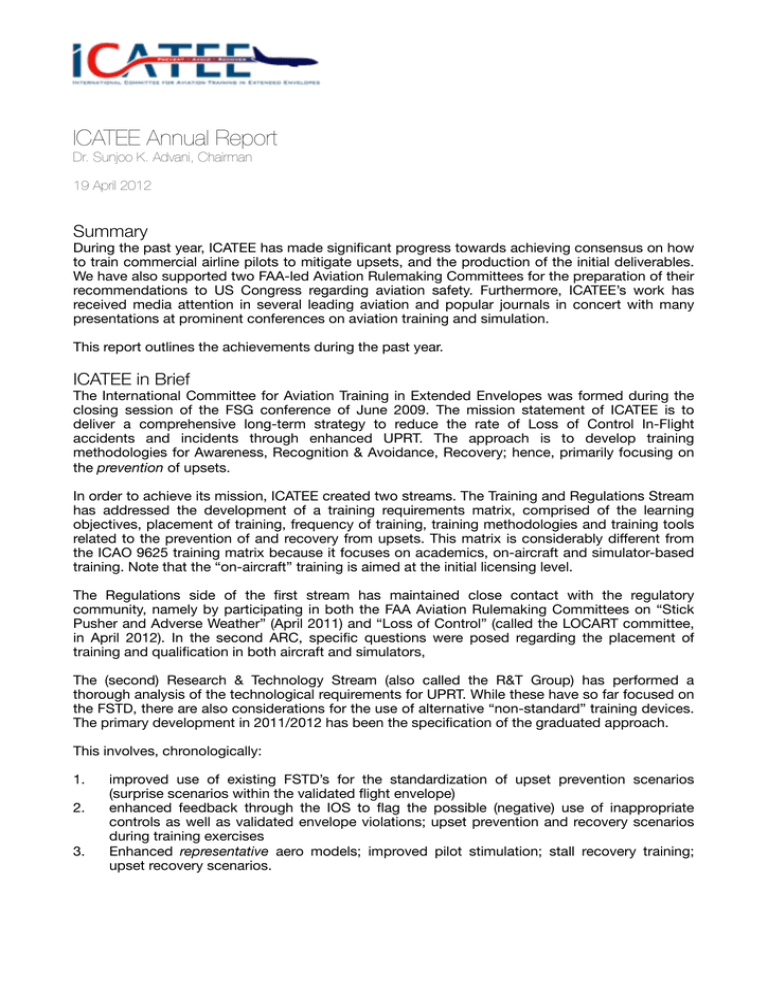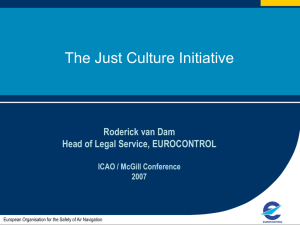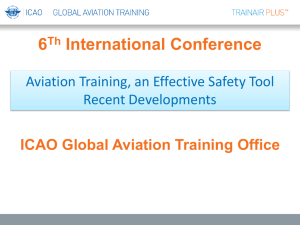ICATEE Annual Report April 2012 - International Committee for
advertisement

ICATEE Annual Report Dr. Sunjoo K. Advani, Chairman 19 April 2012 Summary During the past year, ICATEE has made significant progress towards achieving consensus on how to train commercial airline pilots to mitigate upsets, and the production of the initial deliverables. We have also supported two FAA-led Aviation Rulemaking Committees for the preparation of their recommendations to US Congress regarding aviation safety. Furthermore, ICATEE’s work has received media attention in several leading aviation and popular journals in concert with many presentations at prominent conferences on aviation training and simulation. This report outlines the achievements during the past year. ICATEE in Brief The International Committee for Aviation Training in Extended Envelopes was formed during the closing session of the FSG conference of June 2009. The mission statement of ICATEE is to deliver a comprehensive long-term strategy to reduce the rate of Loss of Control In-Flight accidents and incidents through enhanced UPRT. The approach is to develop training methodologies for Awareness, Recognition & Avoidance, Recovery; hence, primarily focusing on the prevention of upsets. In order to achieve its mission, ICATEE created two streams. The Training and Regulations Stream has addressed the development of a training requirements matrix, comprised of the learning objectives, placement of training, frequency of training, training methodologies and training tools related to the prevention of and recovery from upsets. This matrix is considerably different from the ICAO 9625 training matrix because it focuses on academics, on-aircraft and simulator-based training. Note that the “on-aircraft” training is aimed at the initial licensing level. The Regulations side of the first stream has maintained close contact with the regulatory community, namely by participating in both the FAA Aviation Rulemaking Committees on “Stick Pusher and Adverse Weather” (April 2011) and “Loss of Control” (called the LOCART committee, in April 2012). In the second ARC, specific questions were posed regarding the placement of training and qualification in both aircraft and simulators, The (second) Research & Technology Stream (also called the R&T Group) has performed a thorough analysis of the technological requirements for UPRT. While these have so far focused on the FSTD, there are also considerations for the use of alternative “non-standard” training devices. The primary development in 2011/2012 has been the specification of the graduated approach. This involves, chronologically: 1. 2. 3. improved use of existing FSTD’s for the standardization of upset prevention scenarios (surprise scenarios within the validated flight envelope) enhanced feedback through the IOS to flag the possible (negative) use of inappropriate controls as well as validated envelope violations; upset prevention and recovery scenarios during training exercises Enhanced representative aero models; improved pilot stimulation; stall recovery training; upset recovery scenarios. It is felt that the greatest value lies in the short-term deployment of standardized scenarios and clear definitions of the learning objectives. This will be achieved through the ICATEE Upset Prevention and Recovery Training Manual (see below). The R&T group of ICATEE has developed three significant products in 2011/2012: - The training matrix “roll-up”, whereby the training requirements of the large matrix have been harmonized with the potential training solutions - A Simulator Standards document, that can be appended to current simulator qualification guides such as ICAO 9625, FAR-25 Part 60, or other, to include specific requirements for UPRT - A Research & Technology Report, outlining in detail the technical challenges, current solutions and future on-going activities for the enhancement of UPRT. Training Placement A major development within ICATEE has been the definition on how the training is to occur, for both current pilots (many of whom have a military background with an exposure to the allattitude/all-envelope aircraft), and new-hire career pilots. For the latter, ICATEE is recommending that a small amount of quality-assured on-aircraft training take place, preferably in aerobaticcapable aircraft. This should be combined with simulator based training in both a maneuveroriented training and line-oriented (scenario-based) training-to-proficiency manner. For ALL pilots, ICATEE recommends that the basic academics related to UPRT become part of the training curriculum. This is again defined in the ICATEE UPRT Manual, defined below. To illustrate the UPRT paradigm, ICATEE has developed the process defined in Figure 1. New-hire pilots would be presented with a limited element of on-aircraft training. Current pilots would receive a MOFT session, dedicated to UPRT, followed by the standard LOFT (or, under AQP an LOE) proficiency check, incorporating ICATEE-recommended UPRT elements and scenarios. ALL pilotw would be required to receive the Academics portion regarding the aerodynamics and flight dynamics of upsets. Figure 1 - UPRT placement as recommended by ICATEE. ICAO UPRT Manual The industry-developed Airplane Upset Recovery Training Aid, published in 1998, defines several aspects of aerodynamics, stability and control and airplane performance for pilots in developing awareness with the intention of preventing upsets. ICATEE learned, however, that this document is limited to large swept-wing jets. Clearly, upsets also occur in smaller aircraft, such as turboprops. Hence, ICATEE’s Manuals team is developing a revised version of the training aid, with delineated sections pertaining to: a) pilots b) instructors c) training providers d) regulators Each of these sections will provide guidance regarding the content and recommended best practices for the assurance of high-quality training. It is this Manual that will be presented to ICAO, with the expected date being October 2012. ICATEE publications ICATEE presented papers at the following conferences: RAeS FSG Conference WATS EATS AIAA MST (technical paper) RAeS Flight Crew Training Conference APATS Air & Space Academie February 2011, London April 2011, Orlando June 2011, Istanbul August 2011, Portland, Oregon Sept. 2011, London Sept 2011, Bangkok Nov 2011, Paris ICATEE’s work was published in Maclean’s magazine (cover article), International Herald Tribune (front page), Aviation Week & Space Technology, and Aviation Information Network. ICATEE meetings ICATEE meetings have been held at the following locations: 1 11-09 London 2 03-10 Washington DC 3 04-10 Orlando 4 06-10 London 5 11-10 Oklahoma City 6 03-11 Mesa, Arizona 7 04-11 Daytona Beach, Florida 8 04-11 Orlando 9 06-11 Amsterdam 10 08-11 Seattle 11 09-11 Montreal 12 11-11 London 13 04-12 Lutz, Florida Current Activities and Open Issues ICATEE’s members are involved in the following: a) Training Manuals development - a small, dedicated team is developing the four main sections of these manuals b) Editing the Research & Technology report c) Defining the process by which the Training Matrix can be further validated d) Interfacing with ICAO for the hand-over of the training materials Current open items a) Final definition on how to deal with stall prevention training in stick-pusher equipped aircraft b) Definition of pilot stimulation requirements c) Addressing the issue of skills degradation by defining a long-term assessment plan d) Creating proper MPL language for ICAO 9868 (PANS-TRG) e) Specification of on-going research activities related to loss-of-control in-flight, including: i. Manual control in fourth-generation aircraft ii. Use of non-standard simulation devices (continuous-g, disorientation and other devices) iii. applying objective motion cueing to UPRT-related events Note that an EU project lasting three years has been granted to several of the ICATEE participants, including NLR, DLR, IDT, Airbus, Boeing Europe and other institutes on the subject of Manual Control in 4th Generation Aircraft. This project will begin in September 2012, and falls under the EU’s 7th Framework Programme. This was initiated by the ICATEE chairman. ICATEE Documents and Release Process Currently, much of the basic work on the UPRT Manual is well under way. The content, when assembled, will be reviewed by the leadership of ICATEE, followed by general release to the ICATEE membership. This is expected in October of this year. Thereafter, the document will be presented to the LSB of the RAeS after which it will be handed over to Henry Defalque of ICAO. A Precis of the UPRT Manual is currently being prepared in order to give any interested parties an insight into the detailed content. This should be available by 15 May 2012. The primary outcome of the UPRT Manual will be a recommendation that all future pilots be offered a UPRT Endorsement. We also strongly recommend that a qualification standard be established and required for UPRT instruction, in order to mitigate negative training consequences. The same process will generally apply to the Simulation Standards Document and the Research & Technology Report. The latter is expected to remain an RAeS Publication. After the main documents have been created, a brief document describing the UPRT data requirements for FSTD’s will be produced. This will be destined for IATA. Prognosis for 2012/2013 During the coming year, ICATEE will proceed towards the creation of the initial deliverables for ICAO, primarily the UPRT Manuals. At this point, while the high intensity of the activity will reduce, there is a strong impetus to continue to monitor feedback from industry (training providers and operators) regarding practicality and effectiveness, and regulation (ICAO, FAA and other) regarding the implementation of ICATEE’s recommendations in routine practice. Since ICAO has requested that ICATEE develop and maintain a Manual (rather than a guidance Circular), and because of the specific knowledge required for UPRT, ICATEE must remain intact in the years to come. The ability for ICAO and the FAA to call upon our group’s expertise must remain available, if we are to maintain the highquality standard which ICATEE was intended to establish in this area. Acknowledgments The author and chairman of ICATEE would like to humbly thank his Steering Committee, the Flight Simulation Group, the members of ICATEE, and the Royal Aeronautical Society for their enthusiastic dedication and collaborative, energetic spirit in this most exciting and challenging working group.

